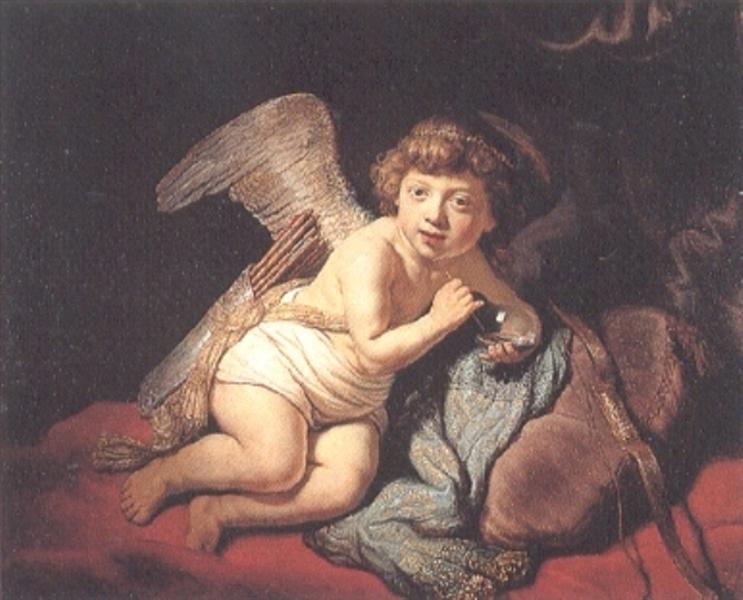Beschreibung
Rembrandt's "Cupid Blowing Soap Bubbles", painted in 1634, is a fascinating testament to the Dutch master's virtuosity and his ability to blend painting technique with the exploration of deeply human and symbolic themes. In this delicate canvas, Rembrandt captures a scene that straddles the threshold between childlike frivolity and emotional depth, set against the backdrop of one of the most iconic mythological figures in art: Cupid.
The painting presents Cupid, the god of love, represented as a naked child, who is in a very dynamic gesture of blowing, emitting a bubble that, in its fragility, symbolizes the ephemeral nature of love and human desires. The arrangement of the character is centered in a composition that draws the viewer's gaze to the crucial act: the creation of the bubble. This gesture, almost like an act of magic or deception, is loaded with meaning. The play of innocence and fragility are combined in the image of Cupid, whose face reflects both joy and concentration on his task, which adds a layer of complexity to the work.
The colours on the canvas are particularly significant. Rembrandt employs a palette of warm, earthy tones, characteristic of the Baroque period, as well as his skill in playing with light and shadow, achieving a three-dimensional effect that brings the child to life. The softness of Cupid's body contrasts with the hardness of the background, which is often distilled into dense shadows, thus creating a powerful visual effect that highlights the main character. This technique, known as tenebrism, is one of the hallmarks of Rembrandt, who had a unique talent for using the contrast between light and shadow to enhance the emotionality of his characters.
It is interesting to note that this work, although less well-known than some of its contemporaries, falls within the tradition of allegorical and mythological portraiture that was popular in painting at the time. Rembrandt, despite his tendency towards depicting the human condition in all its complexity, also explored the lyricism and aesthetics of love in his works. Cupid's connection to eternal love is reinforced through the child's expression and undeniable innocence, allowing the viewer to reflect on the transient bubbles of desire and longing.
The choice to depict such a scene, with a mythological character flirting with the everyday—blowing a bubble—could be interpreted as a veiled criticism or observations on the fleeting nature of youth and love. The bubble, with its volatile nature, symbolizes love in its purest form, but also its fragility. This childhood game, with its tinge of melancholy, is a recurring theme in the work of the artist, who has demonstrated throughout his career a profound reflection on the passage of time and the ephemeral nature of human life.
In conclusion, "Cupid Blowing Soap Bubbles" is not only a work that exhibits Rembrandt's technical mastery, but also invites us to a deep contemplation on the themes of love, innocence and the human condition. Through the representation of a simple but symbolically charged moment, Rembrandt offers us a piece that, although it represents a specific instant in time, resonates with a surprising relevance, showing its universality and the number of layers that can be explored in the work of this great master of Baroque art.
KUADROS ©, a famous painting on your wall.
Hand-made oil painting reproductions, with the quality of professional artists and the distinctive seal of KUADROS ©.
Painting reproduction service with satisfaction guarantee. If you are not completely satisfied with the replica of your painting, we will refund 100% of your money.

